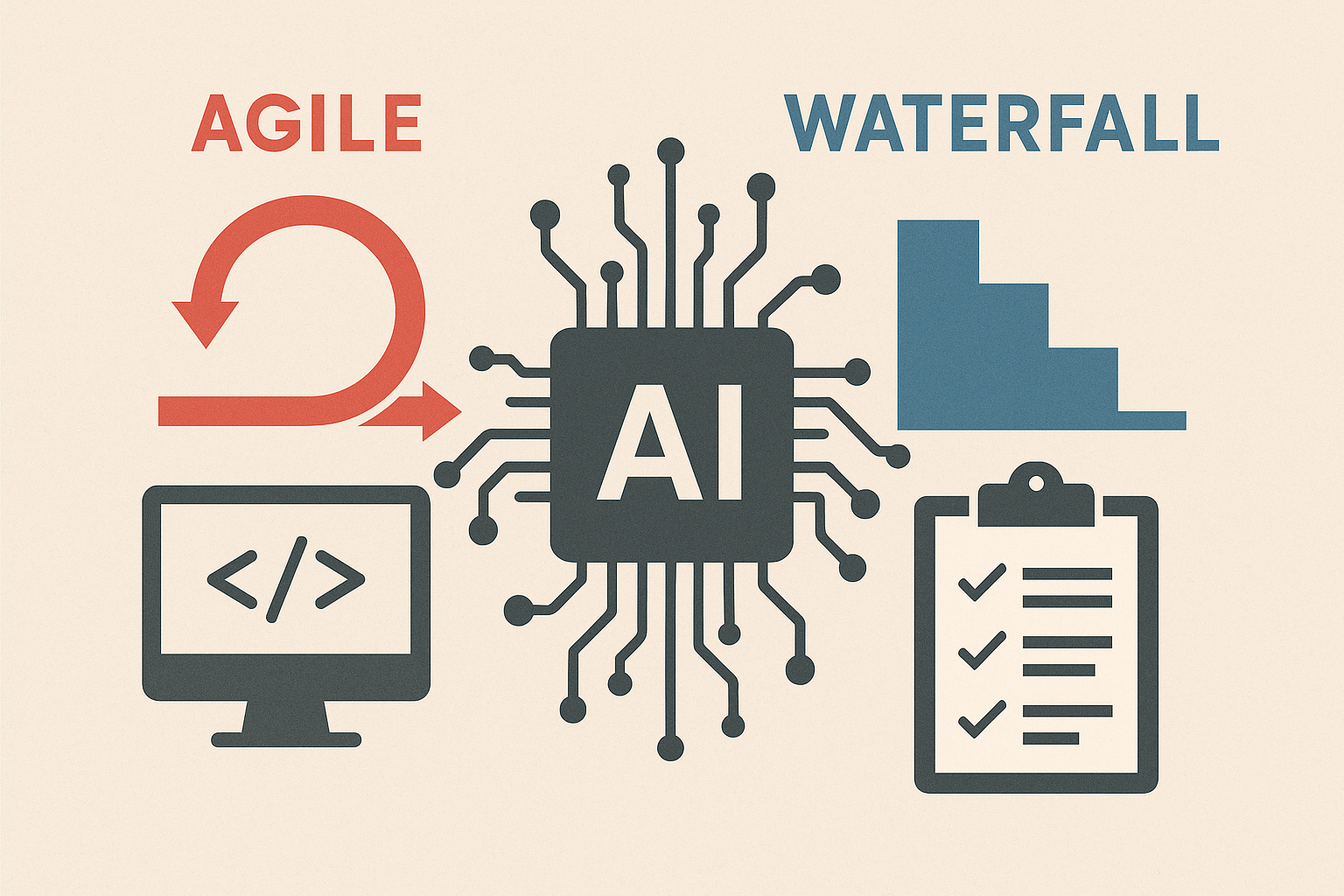For the past twenty-five years, “Agile” has been the gospel of software development. Executives have sat through endless Agile transformation initiatives, watched their organizations install “Scrum Masters,” and wondered why the promised nirvana never quite arrived. Burndown charts, sticky notes, and sprint ceremonies became part of the corporate theatre.
But a quiet revolution is underway, and it has nothing to do with Jira boards or daily standups. Artificial intelligence has flipped the economics of software development. Agile’s assumptions are being undermined. The very reasons we adopted Agile in the first place are evaporating.
This is why a growing number of developers and product leaders are saying something heretical: Agile is dying. And what’s taking its place looks suspiciously like Waterfall—the methodology Agile was supposed to kill.
Why Agile Made Sense in Its Time
Agile emerged at the turn of the millennium as a backlash against Waterfall’s rigidity. In the traditional model, you spent months (or years) gathering requirements, documenting specifications, and planning every detail before a single line of code was written. The philosophy was simple: if we nail the requirements, the project will succeed.
The problem was that users rarely knew what they wanted in advance. Even when they thought they did, their needs changed faster than documentation could keep up. By the time the product launched, the world had moved on. Waterfall turned software into a high-stakes bet with long odds.
Agile’s promise was different: instead of betting everything on getting requirements perfect upfront, build small increments, release fast, and adjust along the way. Developers were expensive, but they could adapt. The iterative loop reduced waste and improved the odds of hitting a moving target.
For two decades, Agile thrived because it matched the economics of software. Developers were costly. Change was costly. Failure was costly. Iteration was the hedge.
The Economic Shift AI Creates
Enter AI. Suddenly, the expensive part of software isn’t the development cycle. Code can be generated, tested, and discarded at a fraction of yesterday’s cost. What once took a sprint now takes an afternoon. The bottleneck has shifted.
When writing code becomes cheap, the limiting factor isn’t implementation. It’s clarity.
- Bad requirements + AI = perfectly wrong software.
- Good requirements + AI = solved problem at speed.
The scarcity has inverted. Developers aren’t the bottleneck anymore. The new scarcity is knowing what to build in the first place.
Vibecoding: Discovery Through Disposable Code
This is where a new practice is emerging, sometimes called vibecoding. Instead of interviewing users, writing long requirements documents, and then “going away to build,” developers sit with users and code alongside them in real time.
The code is throwaway. The point isn’t the software—it’s the discovery. In half an hour, a developer can spin up three working versions of a feature, show them to the user, and learn what actually matters.
One practitioner shared an example:
- User: “I need a dashboard.”
- Developer: codes three dashboards in ten minutes.
- User: “Actually, I need a daily email.”
That discovery would have taken weeks under Agile. Multiple sprint cycles. Dozens of tickets. Now it takes minutes. The throwaway code delivers clarity, and clarity is priceless.
Waterfall Reborn—But Different
This sounds like heresy, but what’s taking shape looks a lot like Waterfall. Not the brittle, thousand-page binders of the 1970s. A modern, AI-enabled Waterfall.
The new model looks like this:
- Spend 90 percent of the effort on requirements. Use vibecoding, prototyping, and rapid exploration to get clarity. Iterate until the “what” is solid.
- Let AI handle the build. With clear requirements, the software can often be generated and validated in days, not months.
In other words: a long waterfall of discovery, followed by a very short waterfall of implementation.
Agile made sense when requirements were fluid and developers were expensive. But in a world where prototyping is cheap and code is practically free, the pendulum swings back.
What Changes for Teams
For executives, this shift has profound implications.
- Product leadership becomes critical. The competitive advantage lies in framing the problem correctly. Leaders who invest in better requirement-gathering methods will outpace competitors still chasing “velocity.”
- Developers become designers of clarity. The best engineers aren’t just code typists—they’re facilitators of discovery, working with users to shape solutions before implementation.
- Agile ceremonies lose relevance. Daily standups and sprint rituals were designed to manage scarce developer time. When code is abundant, those rituals risk becoming theatre.
This doesn’t mean Agile values—adaptability, collaboration, responsiveness—disappear. They simply shift upstream into the requirement discovery phase.
The Dangers of Cheap Code
If this all sounds like good news, there’s a catch.
When implementation is cheap, it’s tempting to move fast without thinking deeply. That leads to perfectly wrong software. AI will happily generate flawless solutions to the wrong problems. The risk is false confidence: “It compiles, so it must be right.”
Executives need to guard against this trap. The safety net is validation. Vibecoding, prototyping, and close user involvement aren’t optional—they’re essential. Code is disposable; clarity is not.
Where Agile Still Matters
Agile isn’t dead everywhere. In regulated industries, safety-critical systems, or projects with long validation cycles, iterative approaches still have value. Agile’s ethos of flexibility and customer collaboration isn’t obsolete—it just lives in a new place.
Think of Agile not as a methodology, but as a mindset that has migrated upstream. Instead of applying it to coding sprints, apply it to requirement discovery. Test assumptions, iterate on clarity, and keep users in the loop.
Requirement Intelligence as the New Advantage
This shift reframes competitive advantage in technology.
For decades, companies prided themselves on hiring top engineers and building large development teams. Code was the differentiator. In the AI era, code is a commodity. What matters is requirement intelligence—the ability to understand, articulate, and validate what customers actually need.
Requirement intelligence becomes intellectual property. The companies that know what to build will dominate. Those that don’t will churn out perfectly wrong products at record speed.
Executives should view this as both an opportunity and a warning. You can no longer buy your way to success by scaling dev teams. The leverage point is clarity.
The Future: Disposable Code, Durable Clarity
Waterfall never really died. Agile never truly won. Both were responses to the cost structures of their time.
- When developers were expensive, Agile made sense.
- When clarity was expensive, Waterfall made sense.
- AI has changed the cost equation again.
We are entering an era where the most valuable thing in software is not the code, but the clarity. Code is disposable. Requirements are durable.
Executives who recognize this shift will position their organizations ahead of the curve. Those who cling to outdated rituals of velocity and iteration risk being left behind.
The future of software isn’t faster sprints—it’s sharper requirements. Waterfall is cool again.
Q&A Summary:
Q: Why is Agile considered to be dying?
A: Artificial intelligence has changed the economics of software development, undermining Agile’s assumptions. With AI, code can be generated, tested, and discarded at a fraction of the cost and time, shifting the bottleneck from development to clarity of requirements.
Q: What is taking the place of Agile methodology?
A: A methodology resembling the Waterfall model, which Agile was initially designed to replace, is taking its place. In this new model, the majority of effort is focused on requirement discovery through practices like vibecoding and prototyping, while AI handles the actual building of the software.
Q: What is 'vibecoding'?
A: Vibecoding is a practice where developers sit with users and code alongside them in real time. The code is disposable and the aim is discovery. This allows developers to quickly create working versions of a feature, show them to the user, and learn what actually matters.
Q: What changes for teams with this new methodology?
A: Product leadership becomes critical as the competitive advantage lies in clearly framing the problem. Developers shift to being facilitators of discovery, working with users to shape solutions before implementation. Agile ceremonies lose relevance as code becomes abundant.
Q: What is the new advantage in technology with this shift?
A: Requirement intelligence becomes the new competitive advantage. The ability to understand, articulate, and validate what customers actually need is now more important than just coding. Companies that know what to build will dominate those that churn out perfectly wrong products at record speed.


